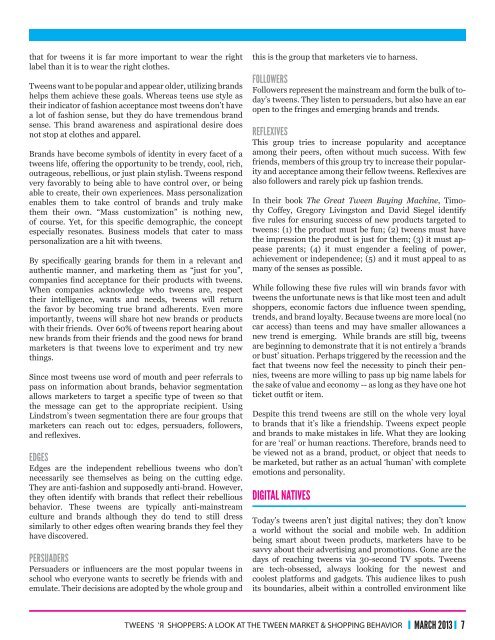Create successful ePaper yourself
Turn your PDF publications into a flip-book with our unique Google optimized e-Paper software.
R’<br />
that for tweens it is far more important to wear the right<br />
label than it is to wear the right clothes.<br />
<strong>Tweens</strong> want to be popular and appear older, utilizing brands<br />
helps them achieve these goals. Whereas teens use style as<br />
their indicator of fashion acceptance most tweens don’t have<br />
a lot of fashion sense, but they do have tremendous brand<br />
sense. This brand awareness and aspirational desire does<br />
not stop at clothes and apparel.<br />
Brands have become symbols of identity in every facet of a<br />
tweens life, offering the opportunity to be trendy, cool, rich,<br />
outrageous, rebellious, or just plain stylish. <strong>Tweens</strong> respond<br />
very favorably to being able to have control over, or being<br />
able to create, their own experiences. Mass personalization<br />
enables them to take control of brands and truly make<br />
them their own. “Mass customization” is nothing new,<br />
of course. Yet, for this specific demographic, the concept<br />
especially resonates. Business models that cater to mass<br />
personalization are a hit with tweens.<br />
By specifically gearing brands for them in a relevant and<br />
authentic manner, and marketing them as “just for you”,<br />
companies find acceptance for their products with tweens.<br />
When companies acknowledge who tweens are, respect<br />
their intelligence, wants and needs, tweens will return<br />
the favor by becoming true brand adherents. Even more<br />
importantly, tweens will share hot new brands or products<br />
with their friends. Over 60% of tweens report hearing about<br />
new brands from their friends and the good news for brand<br />
marketers is that tweens love to experiment and try new<br />
things.<br />
Since most tweens use word of mouth and peer referrals to<br />
pass on information about brands, behavior segmentation<br />
allows marketers to target a specific type of tween so that<br />
the message can get to the appropriate recipient. Using<br />
Lindstrom’s tween segmentation there are four groups that<br />
marketers can reach out to: edges, persuaders, followers,<br />
and reflexives.<br />
EDGES<br />
Edges are the independent rebellious tweens who don’t<br />
necessarily see themselves as being on the cutting edge.<br />
They are anti-fashion and supposedly anti-brand. However,<br />
they often identify with brands that reflect their rebellious<br />
behavior. These tweens are typically anti-mainstream<br />
culture and brands although they do tend to still dress<br />
similarly to other edges often wearing brands they feel they<br />
have discovered.<br />
PERSUADERS<br />
Persuaders or influencers are the most popular tweens in<br />
school who everyone wants to secretly be friends with and<br />
emulate. Their decisions are adopted by the whole group and<br />
this is the group that marketers vie to harness.<br />
FOLLOWERS<br />
Followers represent the mainstream and form the bulk of today’s<br />
tweens. They listen to persuaders, but also have an ear<br />
open to the fringes and emerging brands and trends.<br />
REFLEXIVES<br />
This group tries to increase popularity and acceptance<br />
among their peers, often without much success. With few<br />
friends, members of this group try to increase their popularity<br />
and acceptance among their fellow tweens. Reflexives are<br />
also followers and rarely pick up fashion trends.<br />
In their book The Great Tween Buying Machine, Timothy<br />
Coffey, Gregory Livingston and David Siegel identify<br />
five rules for ensuring success of new products targeted to<br />
tweens: (1) the product must be fun; (2) tweens must have<br />
the impression the product is just for them; (3) it must appease<br />
parents; (4) it must engender a feeling of power,<br />
achievement or independence; (5) and it must appeal to as<br />
many of the senses as possible.<br />
While following these five rules will win brands favor with<br />
tweens the unfortunate news is that like most teen and adult<br />
shoppers, economic factors due influence tween spending,<br />
trends, and brand loyalty. Because tweens are more local (no<br />
car access) than teens and may have smaller allowances a<br />
new trend is emerging. While brands are still big, tweens<br />
are beginning to demonstrate that it is not entirely a ‘brands<br />
or bust’ situation. Perhaps triggered by the recession and the<br />
fact that tweens now feel the necessity to pinch their pennies,<br />
tweens are more willing to pass up big name labels for<br />
the sake of value and economy -- as long as they have one hot<br />
ticket outfit or item.<br />
Despite this trend tweens are still on the whole very loyal<br />
to brands that it’s like a friendship. <strong>Tweens</strong> expect people<br />
and brands to make mistakes in life. What they are looking<br />
for are ‘real’ or human reactions. Therefore, brands need to<br />
be viewed not as a brand, product, or object that needs to<br />
be marketed, but rather as an actual ‘human’ with complete<br />
emotions and personality.<br />
DIGITAL NATIVES<br />
Today’s tweens aren’t just digital natives; they don’t know<br />
a world without the social and mobile web. In addition<br />
being smart about tween products, marketers have to be<br />
savvy about their advertising and promotions. Gone are the<br />
days of reaching tweens via 30-second TV spots. <strong>Tweens</strong><br />
are tech-obsessed, always looking for the newest and<br />
coolest platforms and gadgets. This audience likes to push<br />
its boundaries, albeit within a controlled environment like<br />
TWEENS<br />
SHOPPERS: A LOOK AT THE TWEEN MARKET & SHOPPING BEHAVIOR<br />
MARCH <strong>2013</strong> 7


